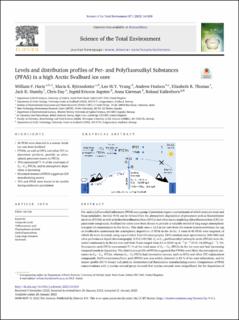Levels and distribution profiles of Per- and Polyfluoroalkyl Substances (PFAS) in a high Arctic Svalbard ice core
Hartz, William F; Björnsdotter, Maria; Yeung, Leo WY.; Hodson, Andrew; Thomas, Elizabeth R; Humby, Jack D.; Day, Chris; Jogsten, Ingrid Ericson; Kallenborn, Roland
Peer reviewed, Journal article
Published version
Date
2023Metadata
Show full item recordCollections
- Import fra CRIStin [3604]
- Institutt for miljø- og naturvitskap [528]
Original version
10.1016/j.scitotenv.2023.161830Abstract
Per- and polyfluoroalkyl substances (PFAS) are a group of persistent organic contaminants of which some are toxic and bioaccumulative. Several PFAS can be formed from the atmospheric degradation of precursors such as fluorotelomer alcohols (FTOHs) as well as hydrochlorofluorocarbons (HFCs) and other ozone-depleting chlorofluorocarbon (CFC) replacement compounds. Svalbard ice cores have been shown to provide a valuable record of long-range atmospheric transport of contaminants to the Arctic. This study uses a 12.3 m ice core from the remote Lomonosovfonna ice cap on Svalbard to understand the atmospheric deposition of PFAS in the Arctic. A total of 45 PFAS were targeted, of which 26 were detected, using supercritical fluid chromatography (SFC) tandem mass spectrometry (MS/MS) and ultra-performance liquid chromatography (UPLC) MS/MS. C2 to C11 perfluoroalkyl carboxylic acids (PFCAs) were detected continuously in the ice core and their fluxes ranged from 2.5 to 8200 ng m−2 yr−1 (9.51–16,500 pg L−1). Trifluoroacetic acid (TFA) represented 71 % of the total mass of C2 – C11 PFCAs in the ice core and had increasing temporal trends in deposition. The distribution profile of PFCAs suggested that FTOHs were likely the atmospheric precursor to C8 – C11 PFCAs, whereas C2 – C6 PFCAs had alternative sources, such as HFCs and other CFC replacement compounds. Perfluorooctanesulfonic acid (PFOS) was also widely detected in 82 % of ice core subsections, and its isomer profile (81 % linear) indicated an electrochemical fluorination manufacturing source. Comparisons of PFAS concentrations with a marine aerosol proxy showed that marine aerosols were insignificant for the deposition of PFAS on Lomonosovfonna. Comparisons with a melt proxy showed that TFA and PFOS were mobile during meltwater percolation. This indicates that seasonal snowmelt and runoff from post-industrial accumulation on glaciers could be a significant seasonal source of PFAS to ecosystems in Arctic fjords.

